Human Resource Management: Contracts, Motivation Theories Analysis
VerifiedAdded on 2023/01/04
|8
|2145
|37
Report
AI Summary
This report delves into key aspects of human resource management (HRM), beginning with a comparison between psychological contracts and contracts of employment. It highlights the unwritten expectations and mutual understandings inherent in psychological contracts, contrasting them with the formal, legally binding nature of employment contracts. The report then explores the significance of psychological contracts in fostering employee engagement and productivity, while also addressing the potential consequences of breaches in these contracts. Furthermore, the report provides an overview of motivation theories, including Maslow's hierarchy of needs, which emphasizes the importance of fulfilling physiological, safety, social, esteem, and self-actualization needs to motivate employees. It also examines Hertzberg's two-factor theory, differentiating between hygiene factors and motivating factors and their impact on job satisfaction and performance. The report concludes by summarizing the key findings and emphasizing the importance of understanding these concepts for effective HRM practices.
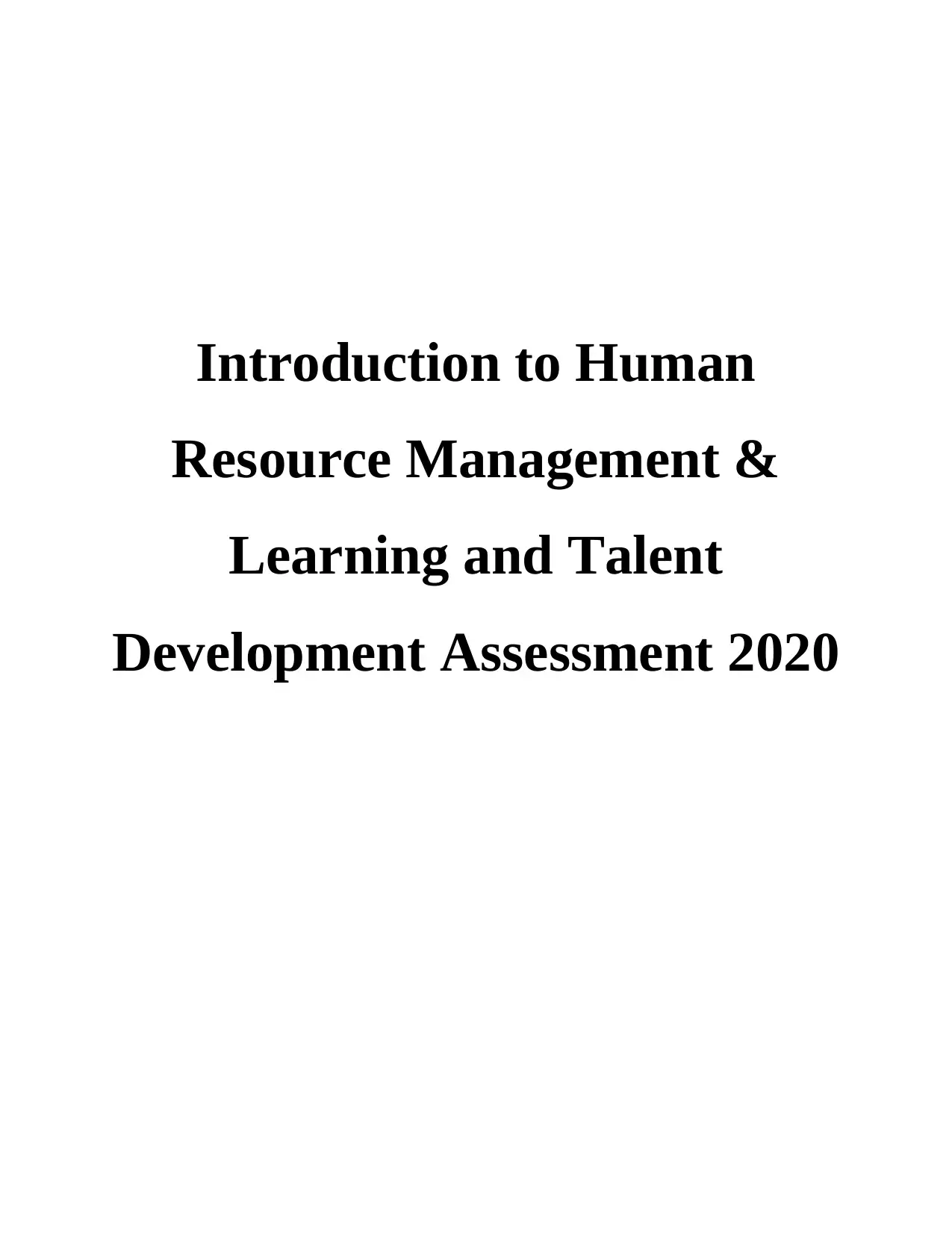
Introduction to Human
Resource Management &
Learning and Talent
Development Assessment 2020
Resource Management &
Learning and Talent
Development Assessment 2020
Paraphrase This Document
Need a fresh take? Get an instant paraphrase of this document with our AI Paraphraser
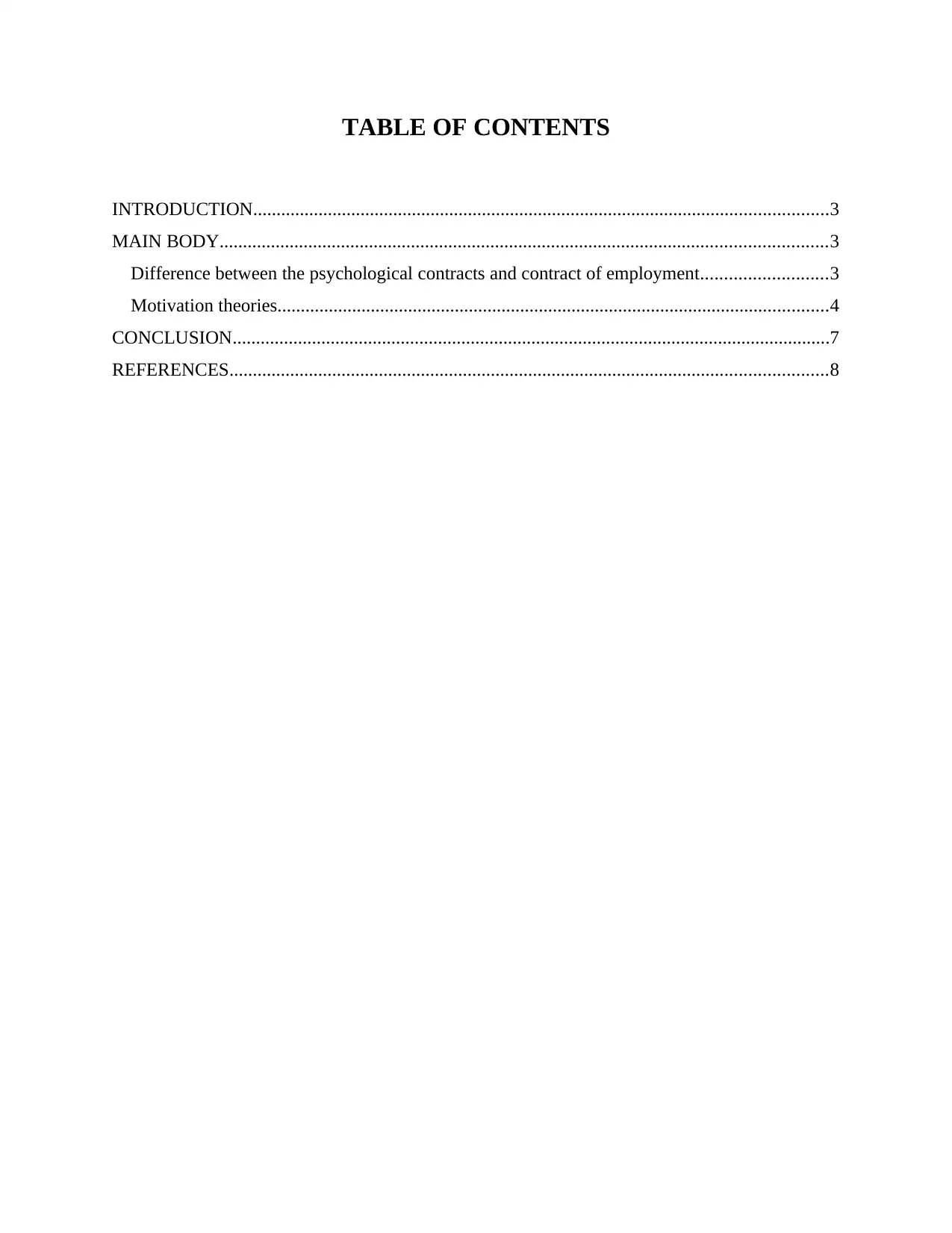
TABLE OF CONTENTS
INTRODUCTION...........................................................................................................................3
MAIN BODY..................................................................................................................................3
Difference between the psychological contracts and contract of employment...........................3
Motivation theories......................................................................................................................4
CONCLUSION................................................................................................................................7
REFERENCES................................................................................................................................8
INTRODUCTION...........................................................................................................................3
MAIN BODY..................................................................................................................................3
Difference between the psychological contracts and contract of employment...........................3
Motivation theories......................................................................................................................4
CONCLUSION................................................................................................................................7
REFERENCES................................................................................................................................8
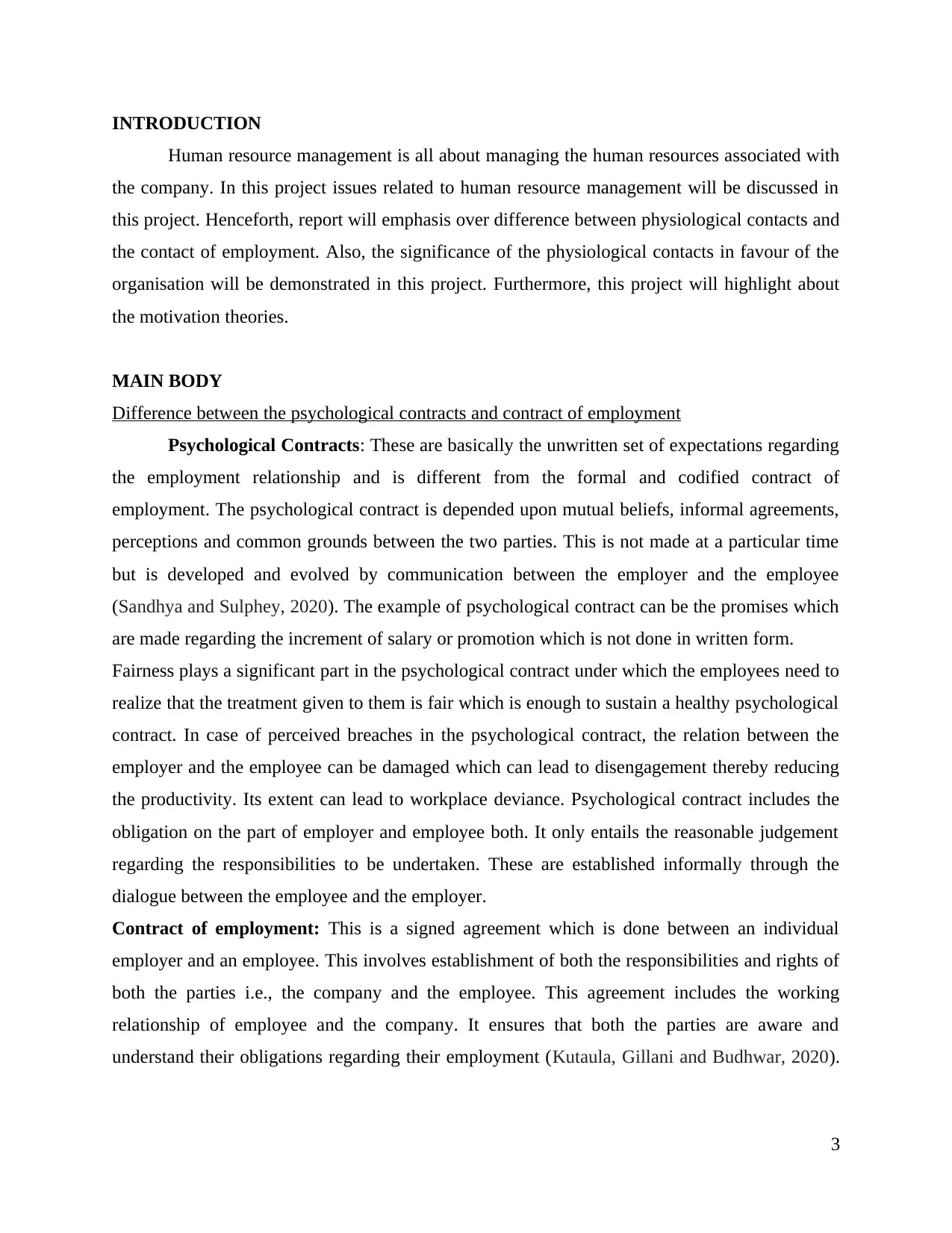
INTRODUCTION
Human resource management is all about managing the human resources associated with
the company. In this project issues related to human resource management will be discussed in
this project. Henceforth, report will emphasis over difference between physiological contacts and
the contact of employment. Also, the significance of the physiological contacts in favour of the
organisation will be demonstrated in this project. Furthermore, this project will highlight about
the motivation theories.
MAIN BODY
Difference between the psychological contracts and contract of employment
Psychological Contracts: These are basically the unwritten set of expectations regarding
the employment relationship and is different from the formal and codified contract of
employment. The psychological contract is depended upon mutual beliefs, informal agreements,
perceptions and common grounds between the two parties. This is not made at a particular time
but is developed and evolved by communication between the employer and the employee
(Sandhya and Sulphey, 2020). The example of psychological contract can be the promises which
are made regarding the increment of salary or promotion which is not done in written form.
Fairness plays a significant part in the psychological contract under which the employees need to
realize that the treatment given to them is fair which is enough to sustain a healthy psychological
contract. In case of perceived breaches in the psychological contract, the relation between the
employer and the employee can be damaged which can lead to disengagement thereby reducing
the productivity. Its extent can lead to workplace deviance. Psychological contract includes the
obligation on the part of employer and employee both. It only entails the reasonable judgement
regarding the responsibilities to be undertaken. These are established informally through the
dialogue between the employee and the employer.
Contract of employment: This is a signed agreement which is done between an individual
employer and an employee. This involves establishment of both the responsibilities and rights of
both the parties i.e., the company and the employee. This agreement includes the working
relationship of employee and the company. It ensures that both the parties are aware and
understand their obligations regarding their employment (Kutaula, Gillani and Budhwar, 2020).
3
Human resource management is all about managing the human resources associated with
the company. In this project issues related to human resource management will be discussed in
this project. Henceforth, report will emphasis over difference between physiological contacts and
the contact of employment. Also, the significance of the physiological contacts in favour of the
organisation will be demonstrated in this project. Furthermore, this project will highlight about
the motivation theories.
MAIN BODY
Difference between the psychological contracts and contract of employment
Psychological Contracts: These are basically the unwritten set of expectations regarding
the employment relationship and is different from the formal and codified contract of
employment. The psychological contract is depended upon mutual beliefs, informal agreements,
perceptions and common grounds between the two parties. This is not made at a particular time
but is developed and evolved by communication between the employer and the employee
(Sandhya and Sulphey, 2020). The example of psychological contract can be the promises which
are made regarding the increment of salary or promotion which is not done in written form.
Fairness plays a significant part in the psychological contract under which the employees need to
realize that the treatment given to them is fair which is enough to sustain a healthy psychological
contract. In case of perceived breaches in the psychological contract, the relation between the
employer and the employee can be damaged which can lead to disengagement thereby reducing
the productivity. Its extent can lead to workplace deviance. Psychological contract includes the
obligation on the part of employer and employee both. It only entails the reasonable judgement
regarding the responsibilities to be undertaken. These are established informally through the
dialogue between the employee and the employer.
Contract of employment: This is a signed agreement which is done between an individual
employer and an employee. This involves establishment of both the responsibilities and rights of
both the parties i.e., the company and the employee. This agreement includes the working
relationship of employee and the company. It ensures that both the parties are aware and
understand their obligations regarding their employment (Kutaula, Gillani and Budhwar, 2020).
3
⊘ This is a preview!⊘
Do you want full access?
Subscribe today to unlock all pages.

Trusted by 1+ million students worldwide
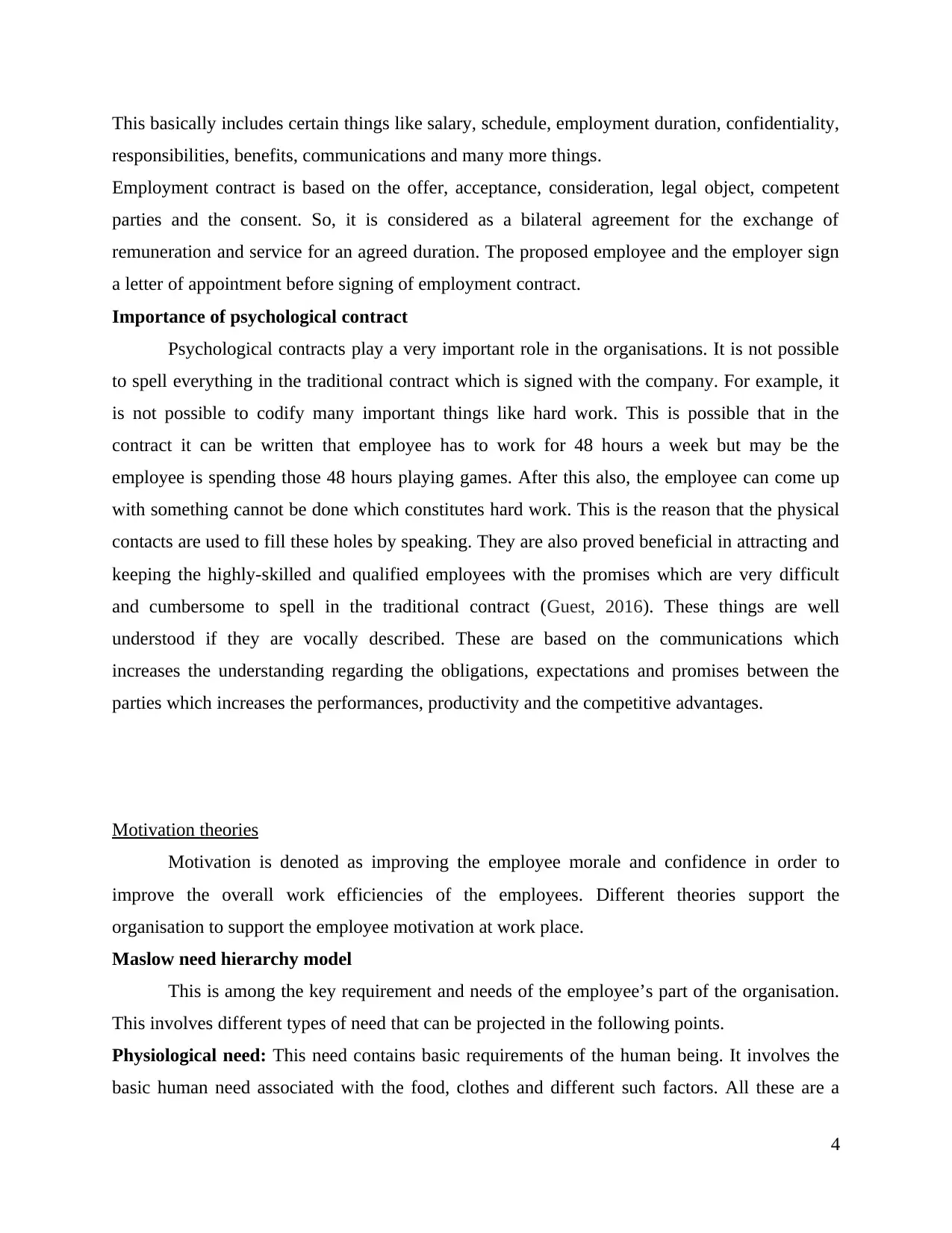
This basically includes certain things like salary, schedule, employment duration, confidentiality,
responsibilities, benefits, communications and many more things.
Employment contract is based on the offer, acceptance, consideration, legal object, competent
parties and the consent. So, it is considered as a bilateral agreement for the exchange of
remuneration and service for an agreed duration. The proposed employee and the employer sign
a letter of appointment before signing of employment contract.
Importance of psychological contract
Psychological contracts play a very important role in the organisations. It is not possible
to spell everything in the traditional contract which is signed with the company. For example, it
is not possible to codify many important things like hard work. This is possible that in the
contract it can be written that employee has to work for 48 hours a week but may be the
employee is spending those 48 hours playing games. After this also, the employee can come up
with something cannot be done which constitutes hard work. This is the reason that the physical
contacts are used to fill these holes by speaking. They are also proved beneficial in attracting and
keeping the highly-skilled and qualified employees with the promises which are very difficult
and cumbersome to spell in the traditional contract (Guest, 2016). These things are well
understood if they are vocally described. These are based on the communications which
increases the understanding regarding the obligations, expectations and promises between the
parties which increases the performances, productivity and the competitive advantages.
Motivation theories
Motivation is denoted as improving the employee morale and confidence in order to
improve the overall work efficiencies of the employees. Different theories support the
organisation to support the employee motivation at work place.
Maslow need hierarchy model
This is among the key requirement and needs of the employee’s part of the organisation.
This involves different types of need that can be projected in the following points.
Physiological need: This need contains basic requirements of the human being. It involves the
basic human need associated with the food, clothes and different such factors. All these are a
4
responsibilities, benefits, communications and many more things.
Employment contract is based on the offer, acceptance, consideration, legal object, competent
parties and the consent. So, it is considered as a bilateral agreement for the exchange of
remuneration and service for an agreed duration. The proposed employee and the employer sign
a letter of appointment before signing of employment contract.
Importance of psychological contract
Psychological contracts play a very important role in the organisations. It is not possible
to spell everything in the traditional contract which is signed with the company. For example, it
is not possible to codify many important things like hard work. This is possible that in the
contract it can be written that employee has to work for 48 hours a week but may be the
employee is spending those 48 hours playing games. After this also, the employee can come up
with something cannot be done which constitutes hard work. This is the reason that the physical
contacts are used to fill these holes by speaking. They are also proved beneficial in attracting and
keeping the highly-skilled and qualified employees with the promises which are very difficult
and cumbersome to spell in the traditional contract (Guest, 2016). These things are well
understood if they are vocally described. These are based on the communications which
increases the understanding regarding the obligations, expectations and promises between the
parties which increases the performances, productivity and the competitive advantages.
Motivation theories
Motivation is denoted as improving the employee morale and confidence in order to
improve the overall work efficiencies of the employees. Different theories support the
organisation to support the employee motivation at work place.
Maslow need hierarchy model
This is among the key requirement and needs of the employee’s part of the organisation.
This involves different types of need that can be projected in the following points.
Physiological need: This need contains basic requirements of the human being. It involves the
basic human need associated with the food, clothes and different such factors. All these are a
4
Paraphrase This Document
Need a fresh take? Get an instant paraphrase of this document with our AI Paraphraser
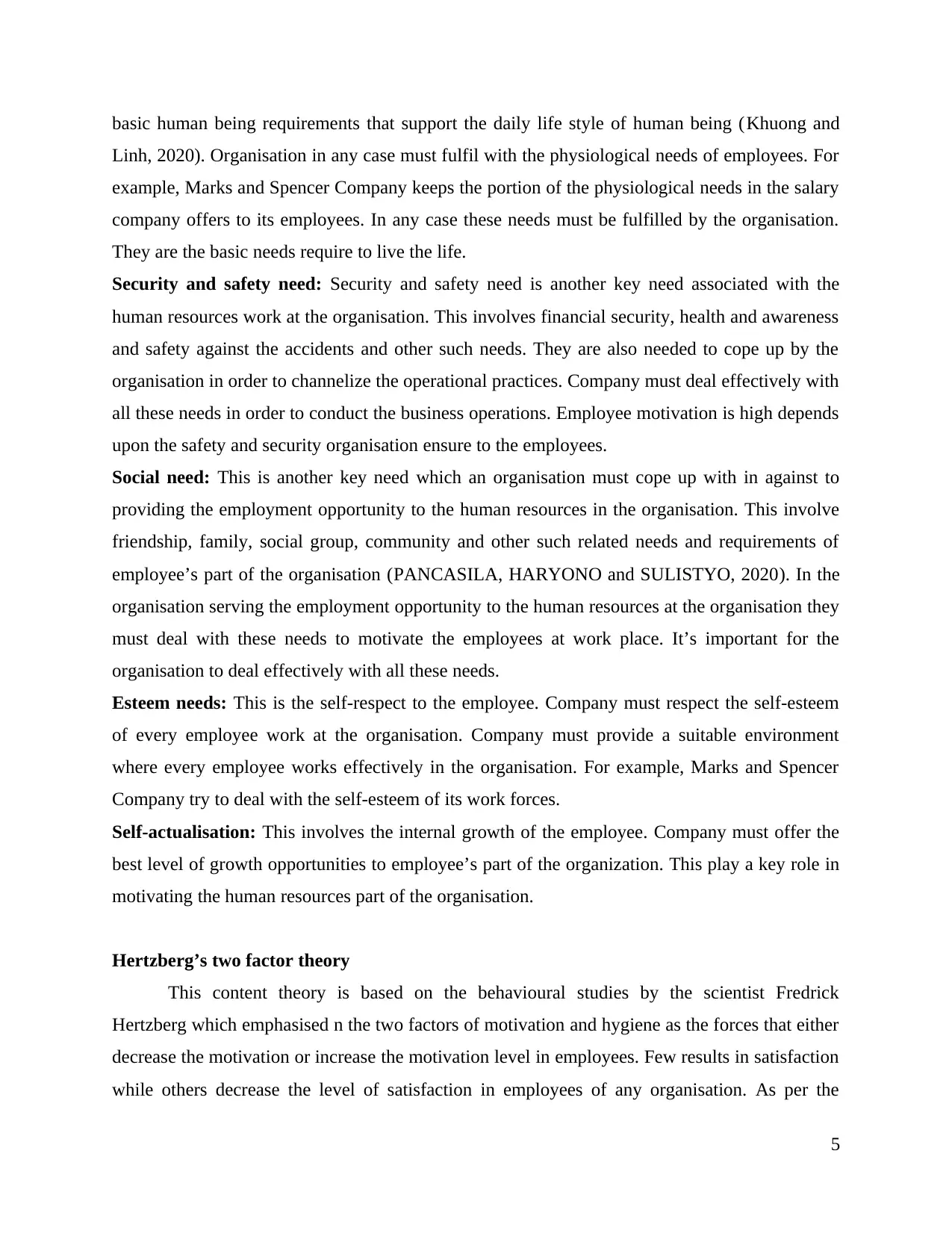
basic human being requirements that support the daily life style of human being (Khuong and
Linh, 2020). Organisation in any case must fulfil with the physiological needs of employees. For
example, Marks and Spencer Company keeps the portion of the physiological needs in the salary
company offers to its employees. In any case these needs must be fulfilled by the organisation.
They are the basic needs require to live the life.
Security and safety need: Security and safety need is another key need associated with the
human resources work at the organisation. This involves financial security, health and awareness
and safety against the accidents and other such needs. They are also needed to cope up by the
organisation in order to channelize the operational practices. Company must deal effectively with
all these needs in order to conduct the business operations. Employee motivation is high depends
upon the safety and security organisation ensure to the employees.
Social need: This is another key need which an organisation must cope up with in against to
providing the employment opportunity to the human resources in the organisation. This involve
friendship, family, social group, community and other such related needs and requirements of
employee’s part of the organisation (PANCASILA, HARYONO and SULISTYO, 2020). In the
organisation serving the employment opportunity to the human resources at the organisation they
must deal with these needs to motivate the employees at work place. It’s important for the
organisation to deal effectively with all these needs.
Esteem needs: This is the self-respect to the employee. Company must respect the self-esteem
of every employee work at the organisation. Company must provide a suitable environment
where every employee works effectively in the organisation. For example, Marks and Spencer
Company try to deal with the self-esteem of its work forces.
Self-actualisation: This involves the internal growth of the employee. Company must offer the
best level of growth opportunities to employee’s part of the organization. This play a key role in
motivating the human resources part of the organisation.
Hertzberg’s two factor theory
This content theory is based on the behavioural studies by the scientist Fredrick
Hertzberg which emphasised n the two factors of motivation and hygiene as the forces that either
decrease the motivation or increase the motivation level in employees. Few results in satisfaction
while others decrease the level of satisfaction in employees of any organisation. As per the
5
Linh, 2020). Organisation in any case must fulfil with the physiological needs of employees. For
example, Marks and Spencer Company keeps the portion of the physiological needs in the salary
company offers to its employees. In any case these needs must be fulfilled by the organisation.
They are the basic needs require to live the life.
Security and safety need: Security and safety need is another key need associated with the
human resources work at the organisation. This involves financial security, health and awareness
and safety against the accidents and other such needs. They are also needed to cope up by the
organisation in order to channelize the operational practices. Company must deal effectively with
all these needs in order to conduct the business operations. Employee motivation is high depends
upon the safety and security organisation ensure to the employees.
Social need: This is another key need which an organisation must cope up with in against to
providing the employment opportunity to the human resources in the organisation. This involve
friendship, family, social group, community and other such related needs and requirements of
employee’s part of the organisation (PANCASILA, HARYONO and SULISTYO, 2020). In the
organisation serving the employment opportunity to the human resources at the organisation they
must deal with these needs to motivate the employees at work place. It’s important for the
organisation to deal effectively with all these needs.
Esteem needs: This is the self-respect to the employee. Company must respect the self-esteem
of every employee work at the organisation. Company must provide a suitable environment
where every employee works effectively in the organisation. For example, Marks and Spencer
Company try to deal with the self-esteem of its work forces.
Self-actualisation: This involves the internal growth of the employee. Company must offer the
best level of growth opportunities to employee’s part of the organization. This play a key role in
motivating the human resources part of the organisation.
Hertzberg’s two factor theory
This content theory is based on the behavioural studies by the scientist Fredrick
Hertzberg which emphasised n the two factors of motivation and hygiene as the forces that either
decrease the motivation or increase the motivation level in employees. Few results in satisfaction
while others decrease the level of satisfaction in employees of any organisation. As per the
5
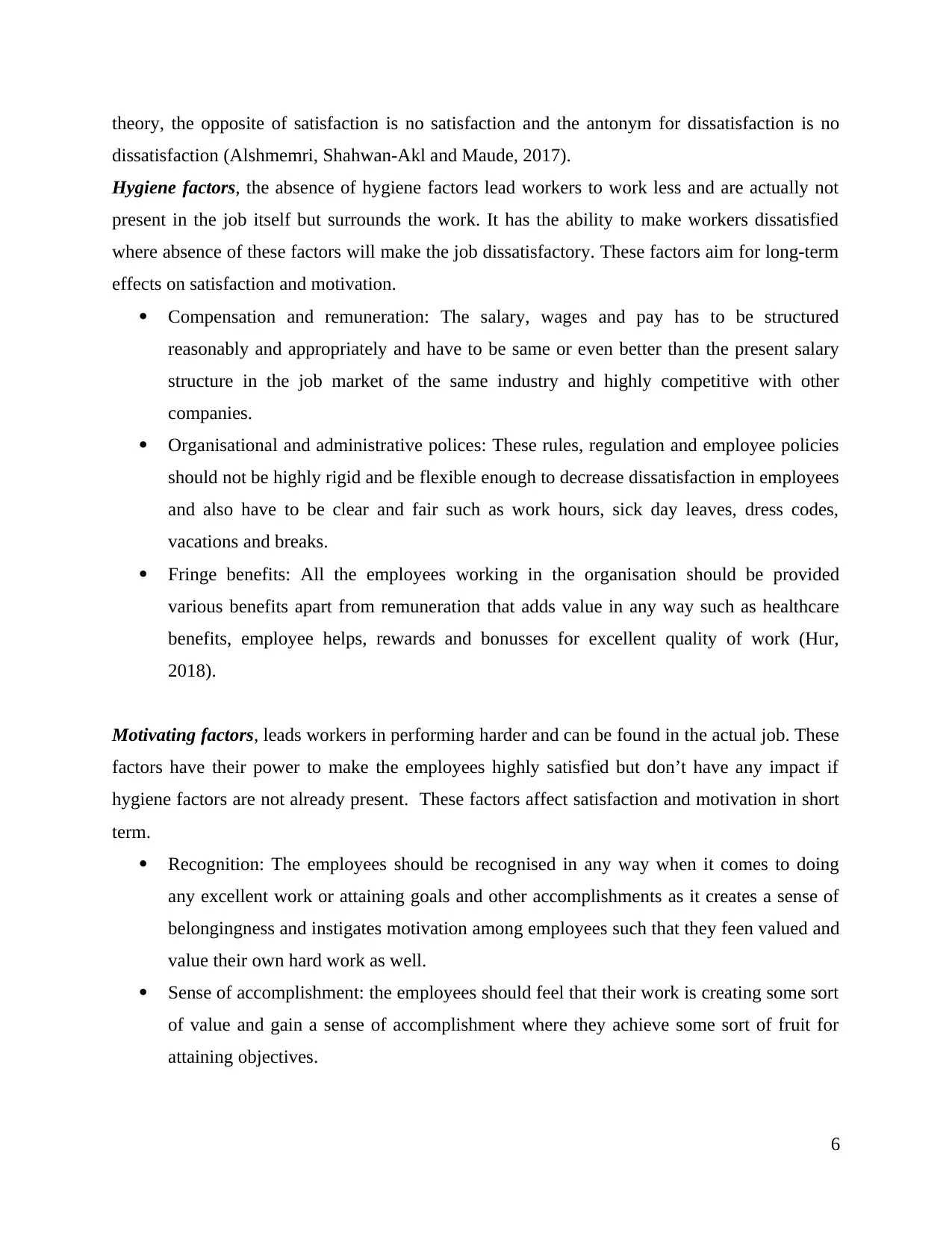
theory, the opposite of satisfaction is no satisfaction and the antonym for dissatisfaction is no
dissatisfaction (Alshmemri, Shahwan-Akl and Maude, 2017).
Hygiene factors, the absence of hygiene factors lead workers to work less and are actually not
present in the job itself but surrounds the work. It has the ability to make workers dissatisfied
where absence of these factors will make the job dissatisfactory. These factors aim for long-term
effects on satisfaction and motivation.
Compensation and remuneration: The salary, wages and pay has to be structured
reasonably and appropriately and have to be same or even better than the present salary
structure in the job market of the same industry and highly competitive with other
companies.
Organisational and administrative polices: These rules, regulation and employee policies
should not be highly rigid and be flexible enough to decrease dissatisfaction in employees
and also have to be clear and fair such as work hours, sick day leaves, dress codes,
vacations and breaks.
Fringe benefits: All the employees working in the organisation should be provided
various benefits apart from remuneration that adds value in any way such as healthcare
benefits, employee helps, rewards and bonusses for excellent quality of work (Hur,
2018).
Motivating factors, leads workers in performing harder and can be found in the actual job. These
factors have their power to make the employees highly satisfied but don’t have any impact if
hygiene factors are not already present. These factors affect satisfaction and motivation in short
term.
Recognition: The employees should be recognised in any way when it comes to doing
any excellent work or attaining goals and other accomplishments as it creates a sense of
belongingness and instigates motivation among employees such that they feen valued and
value their own hard work as well.
Sense of accomplishment: the employees should feel that their work is creating some sort
of value and gain a sense of accomplishment where they achieve some sort of fruit for
attaining objectives.
6
dissatisfaction (Alshmemri, Shahwan-Akl and Maude, 2017).
Hygiene factors, the absence of hygiene factors lead workers to work less and are actually not
present in the job itself but surrounds the work. It has the ability to make workers dissatisfied
where absence of these factors will make the job dissatisfactory. These factors aim for long-term
effects on satisfaction and motivation.
Compensation and remuneration: The salary, wages and pay has to be structured
reasonably and appropriately and have to be same or even better than the present salary
structure in the job market of the same industry and highly competitive with other
companies.
Organisational and administrative polices: These rules, regulation and employee policies
should not be highly rigid and be flexible enough to decrease dissatisfaction in employees
and also have to be clear and fair such as work hours, sick day leaves, dress codes,
vacations and breaks.
Fringe benefits: All the employees working in the organisation should be provided
various benefits apart from remuneration that adds value in any way such as healthcare
benefits, employee helps, rewards and bonusses for excellent quality of work (Hur,
2018).
Motivating factors, leads workers in performing harder and can be found in the actual job. These
factors have their power to make the employees highly satisfied but don’t have any impact if
hygiene factors are not already present. These factors affect satisfaction and motivation in short
term.
Recognition: The employees should be recognised in any way when it comes to doing
any excellent work or attaining goals and other accomplishments as it creates a sense of
belongingness and instigates motivation among employees such that they feen valued and
value their own hard work as well.
Sense of accomplishment: the employees should feel that their work is creating some sort
of value and gain a sense of accomplishment where they achieve some sort of fruit for
attaining objectives.
6
⊘ This is a preview!⊘
Do you want full access?
Subscribe today to unlock all pages.

Trusted by 1+ million students worldwide
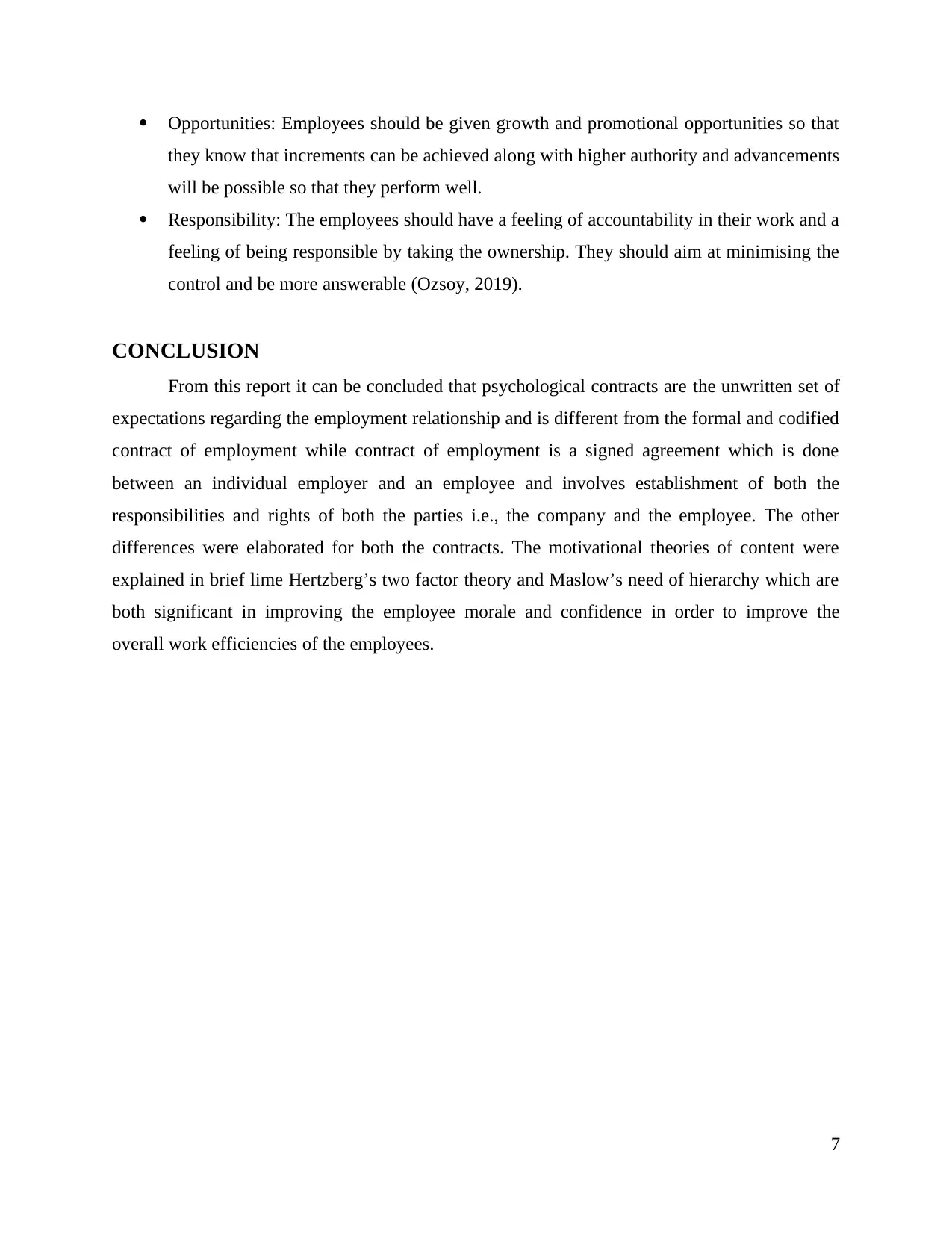
Opportunities: Employees should be given growth and promotional opportunities so that
they know that increments can be achieved along with higher authority and advancements
will be possible so that they perform well.
Responsibility: The employees should have a feeling of accountability in their work and a
feeling of being responsible by taking the ownership. They should aim at minimising the
control and be more answerable (Ozsoy, 2019).
CONCLUSION
From this report it can be concluded that psychological contracts are the unwritten set of
expectations regarding the employment relationship and is different from the formal and codified
contract of employment while contract of employment is a signed agreement which is done
between an individual employer and an employee and involves establishment of both the
responsibilities and rights of both the parties i.e., the company and the employee. The other
differences were elaborated for both the contracts. The motivational theories of content were
explained in brief lime Hertzberg’s two factor theory and Maslow’s need of hierarchy which are
both significant in improving the employee morale and confidence in order to improve the
overall work efficiencies of the employees.
7
they know that increments can be achieved along with higher authority and advancements
will be possible so that they perform well.
Responsibility: The employees should have a feeling of accountability in their work and a
feeling of being responsible by taking the ownership. They should aim at minimising the
control and be more answerable (Ozsoy, 2019).
CONCLUSION
From this report it can be concluded that psychological contracts are the unwritten set of
expectations regarding the employment relationship and is different from the formal and codified
contract of employment while contract of employment is a signed agreement which is done
between an individual employer and an employee and involves establishment of both the
responsibilities and rights of both the parties i.e., the company and the employee. The other
differences were elaborated for both the contracts. The motivational theories of content were
explained in brief lime Hertzberg’s two factor theory and Maslow’s need of hierarchy which are
both significant in improving the employee morale and confidence in order to improve the
overall work efficiencies of the employees.
7
Paraphrase This Document
Need a fresh take? Get an instant paraphrase of this document with our AI Paraphraser
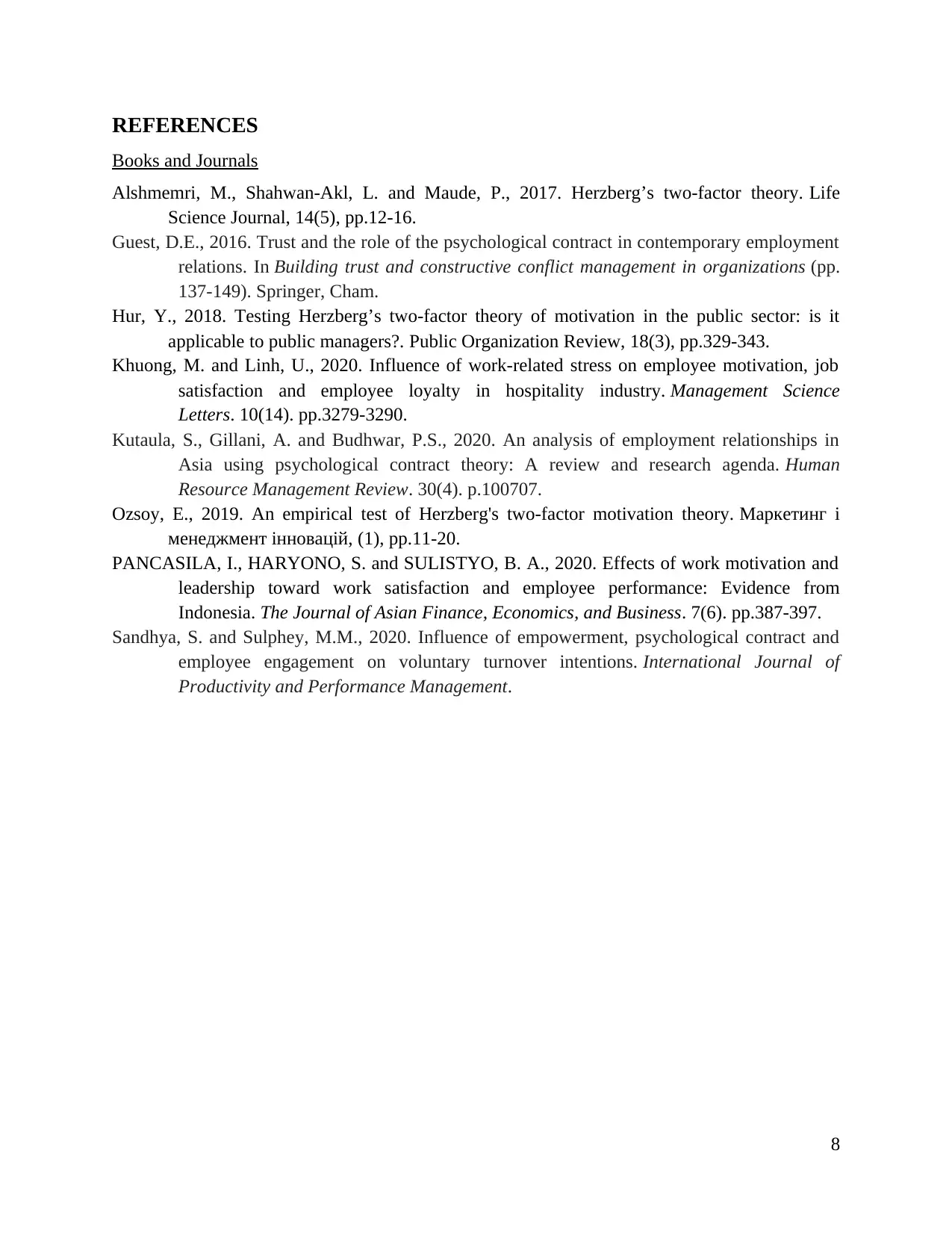
REFERENCES
Books and Journals
Alshmemri, M., Shahwan-Akl, L. and Maude, P., 2017. Herzberg’s two-factor theory. Life
Science Journal, 14(5), pp.12-16.
Guest, D.E., 2016. Trust and the role of the psychological contract in contemporary employment
relations. In Building trust and constructive conflict management in organizations (pp.
137-149). Springer, Cham.
Hur, Y., 2018. Testing Herzberg’s two-factor theory of motivation in the public sector: is it
applicable to public managers?. Public Organization Review, 18(3), pp.329-343.
Khuong, M. and Linh, U., 2020. Influence of work-related stress on employee motivation, job
satisfaction and employee loyalty in hospitality industry. Management Science
Letters. 10(14). pp.3279-3290.
Kutaula, S., Gillani, A. and Budhwar, P.S., 2020. An analysis of employment relationships in
Asia using psychological contract theory: A review and research agenda. Human
Resource Management Review. 30(4). p.100707.
Ozsoy, E., 2019. An empirical test of Herzberg's two-factor motivation theory. Маркетинг і
менеджмент інновацій, (1), pp.11-20.
PANCASILA, I., HARYONO, S. and SULISTYO, B. A., 2020. Effects of work motivation and
leadership toward work satisfaction and employee performance: Evidence from
Indonesia. The Journal of Asian Finance, Economics, and Business. 7(6). pp.387-397.
Sandhya, S. and Sulphey, M.M., 2020. Influence of empowerment, psychological contract and
employee engagement on voluntary turnover intentions. International Journal of
Productivity and Performance Management.
8
Books and Journals
Alshmemri, M., Shahwan-Akl, L. and Maude, P., 2017. Herzberg’s two-factor theory. Life
Science Journal, 14(5), pp.12-16.
Guest, D.E., 2016. Trust and the role of the psychological contract in contemporary employment
relations. In Building trust and constructive conflict management in organizations (pp.
137-149). Springer, Cham.
Hur, Y., 2018. Testing Herzberg’s two-factor theory of motivation in the public sector: is it
applicable to public managers?. Public Organization Review, 18(3), pp.329-343.
Khuong, M. and Linh, U., 2020. Influence of work-related stress on employee motivation, job
satisfaction and employee loyalty in hospitality industry. Management Science
Letters. 10(14). pp.3279-3290.
Kutaula, S., Gillani, A. and Budhwar, P.S., 2020. An analysis of employment relationships in
Asia using psychological contract theory: A review and research agenda. Human
Resource Management Review. 30(4). p.100707.
Ozsoy, E., 2019. An empirical test of Herzberg's two-factor motivation theory. Маркетинг і
менеджмент інновацій, (1), pp.11-20.
PANCASILA, I., HARYONO, S. and SULISTYO, B. A., 2020. Effects of work motivation and
leadership toward work satisfaction and employee performance: Evidence from
Indonesia. The Journal of Asian Finance, Economics, and Business. 7(6). pp.387-397.
Sandhya, S. and Sulphey, M.M., 2020. Influence of empowerment, psychological contract and
employee engagement on voluntary turnover intentions. International Journal of
Productivity and Performance Management.
8
1 out of 8
Related Documents
Your All-in-One AI-Powered Toolkit for Academic Success.
+13062052269
info@desklib.com
Available 24*7 on WhatsApp / Email
![[object Object]](/_next/static/media/star-bottom.7253800d.svg)
Unlock your academic potential
Copyright © 2020–2025 A2Z Services. All Rights Reserved. Developed and managed by ZUCOL.





